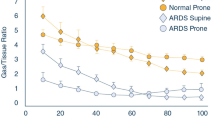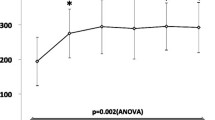Summary
Intermittent prone positioning (PP) is a promising therapy of patients with severe respiratory failure. Evaluations of patient outcomes can not, to dare, be found in the literature. This study was conducted to investigate the effects of intermittent PP on patients with posttraumatic respiratory failure (PaO2/FiO2 < 280 mmHg) in comparison with conventional therapy in suspine position. The collected data is part of our prospective polytrauma study. 136 polytraumized patients (mean ISS 23.4) were included and evaluated. 77 patients had a severe chest trauma with an AIS L 3. Of these, 47 patients developed a respiratory failure. 19 of these patients were treated conventionally in suspine position, 28 patients were intermittingly turned prone. Having similar AIS (3.6 vs. 33), the PP-patients had a significantly severer trauma (ISS 35.8 vs. 24.5). Though the injury severity of the PP-patients was much higher, the time of ventilation (32 vs. 31 d) and the ICU stay (39 vs. 36 d) was similar to the patients treated in suspine position. The mortility of PP-patients was 0 %, of suspine positioned patients 26 %. After the first PP the PaO2/FiO2 ratio increased with an average of 82 mmHg (26–151 mmHg). The FiO2 was reduced from 0.45 (0.35–1.0) to 0.26 (0.21–0.35). Beside the beneficial effect of PP on the oxygenation we have, for the first time evidence that PP improves the outcome of patients with posttraumatic respiratory failure.
Zusammenfassung
Die intermittierende Bauchlagerung (BL) gilt für Patienten mit schwerem respiratorischen Versagen als ein erfolgsversprechender Therapieansatz. Ergebnisse bzgl. des Behandlungsoutcomes liegen nicht vor. Ziel dieser Studie war es Auswirkungen der intermittierenden BL bei Patienten mit posttraumatischem Lungenversagen (PaO2/FiO2 < 280 mmHg) nach Thoraxtrauma im Vergleich zur konventionellen Therapie zu untersuchen. Im Rahmen unserer prospektiven Polytraumastudie wurden die Daten von 136 polytraumatisierten Patienten mit einem mittleren ISS von 23,4 erfaßt und ausgewertet; 77 Patienten hatten ein schweres Thoraxtrauma (AIS L 3) von denen 47 im weiteren Verlauf ein respiratorisches Versagen entwickelten. 19 dieser Patienten wurden konventionell in Rückenlage therapiert, 28 wurden intermittierend auf dem Bauch gelagert. Bei gleichem AIS-Thorax (3,6 vs. 3,3) waren die Patienten mit BL signifikant schwerer verletzt (ISS 35,8 vs. 24,5). Trotz erhöhter Verletzungsschwere der BL-Patienten war die Beatmungsdauer (32 vs. 31 Tage) und die Behandlungsdauer (ICU: 39 vs. 36 Tage) bei den konventionell therapierten Patienten gleich hoch. Die Letalität betrug bei den BL-Patienten 0 %, bei den konventionell therapierten Patienten 26 % (5 Patienten). Während des ersten Zyklus in BL verbesserte sich der Oxygenierungsquotient (PaO2/FiO2) im Durchschnitt um 82 mmHg (26–151 mmHg). Bei Beendigung der Wechsellagerung war der Oxygenierungsquotient um 111 mmHg (22–257 mmHg) angestiegen. Der FiO2 konnte von 0,45 (0,35–1,0) auf 0,26 (0,21–0,35) reduziert werden. Neben dem positiven Effekt auf den Gasaustausch ergeben sich erstmals deutliche Hinweise, daß die intermittierende BL sich günstig auf den Behandlungsverlauf sowie das Behandlungsergebnis bei Patienten mit posttraumatischem Lungenversagen auswirkt (gleicher Outcome bei höherer Verletzungsschwere der Patienten in BL).
Similar content being viewed by others
Author information
Authors and Affiliations
Rights and permissions
About this article
Cite this article
Erhard, J., Waydhas, C., Ruchholtz, S. et al. Effect of prone positioning on the outcome of patients with posttraumatic respiratory failure. Unfallchirurg 101, 928–934 (1998). https://doi.org/10.1007/s001130050360
Published:
Issue Date:
DOI: https://doi.org/10.1007/s001130050360




